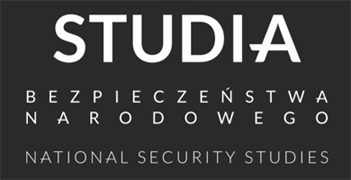ORIGINAL PAPER
EXPLORING NEW FRONTIERS IN ACADEMIC RESEARCH WITHIN SECURITY SCIENCES — METHODS OF SOCIOENERGETIC DISRUPTION
1
Instytut Gospodarki Surowcami Mineralnymi i Energią, Polskiej Akademii Nauk, Polska
2
Wojskowa Akademia Techniczna im. Jarosława Dąbrowskiego w Warszawie, Polska
3
Wydział Górnictwa, Inżynierii Bezpieczeństwa i Automatyki Przemysłowej,, Politechnika Śląska, Polska
These authors had equal contribution to this work
A - Research concept and design; B - Collection and/or assembly of data; C - Data analysis and interpretation; D - Writing the article; E - Critical revision of the article; F - Final approval of article
Submission date: 2025-05-11
Final revision date: 2025-05-30
Acceptance date: 2025-05-30
Publication date: 2025-05-30
Corresponding author
SBN 2025;37(3): 27-42
KEYWORDS
TOPICS
ABSTRACT
The aim of this paper i s to descriptive deconstruction methods of socioenergy balance, which are used or can be used in economic disruption of the adversary (competitor).The main research problem is: what methods of socioenergetic imbalance can be legitimately distinguished from the cybernetic pattern of an autonomous system? The following hypothesis is an attempt to solve the research problem: from the cybernetic model of an autonomous system, one can reasonably derive methods of disrupting the socio-energetic equilibrium by interfering with the circulation of information, control processes, and energy distribution within social systems, which leads to the destabilization of decision- -making structures, disorganization of goals, and disruption of feedback loops essential for the system’s selfregulation and adaptation. The considerations are based on the strategy of theory prior to research and the classical method of inference, analogy, opposites and completeness. The authors uses the terminological conventions found in the theory of autonomous systems/processes, information logic, the theory of action systems. The adversary’s disruption is carried out in two main stages, the first: recognition of the object to be destroyed (passive and active), and the second: proper disruption, which consists of direct and indirect disinformation and proper disorganization (indirect and direct). As a concretization of the direct disorganization method, administrative measures (embargoes) and measures based on trade policy (customs duties) are used. Indirect disorganization involves the disruption of economic norms that determine what is economically beneficial to society and the methods of achieving such benefits. The present paper fits into this current of deliberation and metatheoretical search. It is a promising research direction, which complemented by detailed and monodisciplinary knowledge, can improve and deepen the knowledge of security, its essence, manifestations and possibilities of exercising.
REFERENCES (29)
1.
Blackwill, R. D., and Jennifer M. Harris, 2016. War by Other Means: Geoeconomics and Statecraft. Harvard University Press.
2.
Cabała, Z., 2007. Prakseologiczna analiza działania. Prakseologia, 147 (2007), 9-17.
3.
Cheung, Y-W & Qian, X., 2009, Hoarding of international reserves: Mrs Machlup’s wardrobe and the Joneses’, Review of International Economics, 17(4), 777–801.
4.
Dahl, M., Hanczewski, P., Lewicka, M., 2018. Współczesny ład międzynarodowy. Toruń: Wydawnictwo Adam Marszałek.
5.
Drezner, DW., 2011. Sanctions sometimes smart: targeted sanctions in theory and practice. International Studies Review, 13(1), 96–108.
6.
Dymkowski, D., 2019. Sankcje gospodarcze w kreowaniu bezpieczeństwa państwa. Rozprawa doktorska, Warszawa: WAT.
7.
Farrell, H., Newman, A., 2019. Weaponized Interdependence: How Global Economic Networks Shape State Coercion. International Security 2019, 44 (1).
8.
Goldman, M., 2008. Petrostate: Putin, power and the new Russia, Oxford University Press, Oxford.
10.
Konieczny, J., 2020. Kryminalistyczny leksykon śledztwa. Opole: Uniwersytet Opolski.
15.
Liedel, K., Sereafin, T., 2011. Otwarte źródła informacji w działalności wywiadowczej, Warszawa: Difin.
16.
Mazur, M., 1969. Świadome działanie jako rozwiązanie problemu optymalizacyjnego. Nauczyciel i Wychowanie, 6 (62).
19.
Peksen, D., 2009. Better or worse? The effect of economic sanctions on human rights, Journal of Peace Research, 46(1), 59–77.
20.
Piasecki, S., 1968. Teoria badań operacji. Elementy teorii niszczenia. Warszawa: WAT.
24.
Świniarski, J., Kawalerski P., 2019. Drogi i bezdroża securitologii. Warszawa: WAT.
25.
Świniarski, J., 2004. Filozofia bezpieczeństwa. Warszawa: Akademia Obrony Narodowej.
26.
Świniarski, J., 2023. Philosophy and Social Sciences in a Securitological Perspective. Polish Political Science Yearbook, 52.
28.
Yergin, D., 1991. The prize: the epic quest for oil, money & power, Simon & Schuster, New York.
29.
Zaniewski, Z., 1989. Podstawy interdyscyplinarnej teorii czynników kryminogennych. Warszawa: ASW.
We process personal data collected when visiting the website. The function of obtaining information about users and their behavior is carried out by voluntarily entered information in forms and saving cookies in end devices. Data, including cookies, are used to provide services, improve the user experience and to analyze the traffic in accordance with the Privacy policy. Data are also collected and processed by Google Analytics tool (more).
You can change cookies settings in your browser. Restricted use of cookies in the browser configuration may affect some functionalities of the website.
You can change cookies settings in your browser. Restricted use of cookies in the browser configuration may affect some functionalities of the website.


